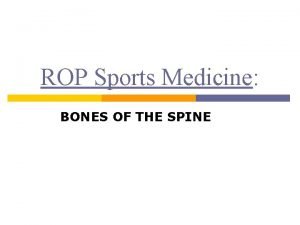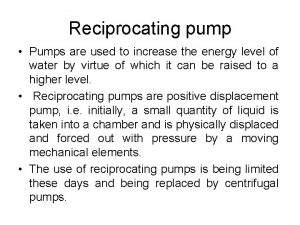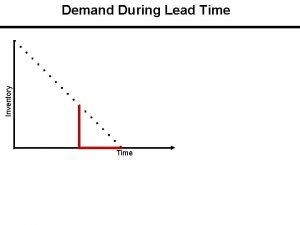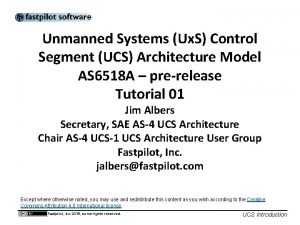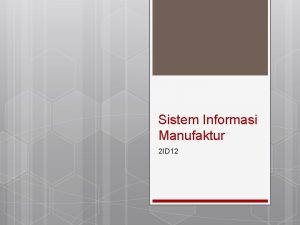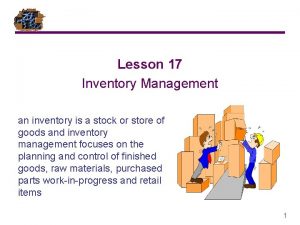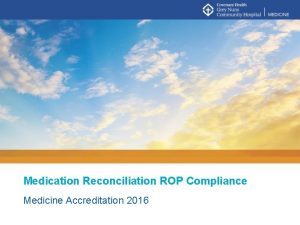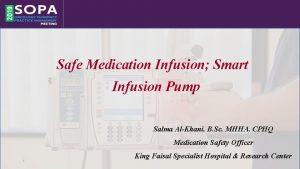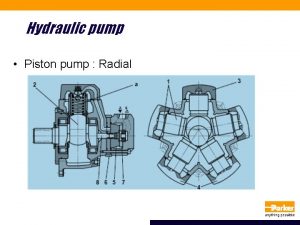Infusion Pump ROP Compliance Medicine Accreditation 2016 A















- Slides: 15

Infusion Pump ROP Compliance Medicine Accreditation 2016

A documented and coordinated approach for infusion pump safety that includes training, evaluation of competence, and a process to report problems with infusion pumps is implemented.

Infusion Pumps • Used to deliver fluids into a clients body in a controlled manner • Used extensively in healthcare including in the home environment • Associated with significant safety issues and harm to clients

ROP Focus • Parenteral Delivery of fluids, medications, blood/blood products, and nutrients. • Includes stationary and mobile pumps, Patient Controlled Analgesia (PCA) epidural pumps, insulin pumps, and large volume pumps. *excludes gastric feeding pumps

Major Tests for Compliance Instructions and user guides for each type of infusion pump are easily accessible at all times. § Compassionnet § AHS Insite

Major Tests for Compliance Initial and retraining on the safe use of infusion pumps is provided to team members: q New staff & staff returning from extended leave q New or upgraded infusion pumps q Competence evaluation indicates re-training

Staff training is required to: • Minimize adverse events • Ensure the appropriate devise is used for each type of therapy • Improve staff competence • Promote reporting of adverse events • Keep current with pump information • When infusion pumps are infrequently used, just in time training is provided.

Medicine @ Covenant Infusion Pump Safety Module on CLIC • Certificate and Exam are tracked using the Medicine Program Tracking Tool Spreadsheet and filed in your Personal file. • Part of New Hire and Return to Work Orientation • Addition to Annual Recertification 2016

Major Tests for Compliance The competence of team members to use infusion pumps safely is evaluated and documented at least every 2 years. *Programs must maintain records of training and competence assessments *Staff must feel confident to use infusion devices or request additional training *online examination can be used to assess competence

Major Tests for Compliance When patients are provided with patient operated infusion pumps, training is provided, and documented, to patients and families on how to use them safely. • Standardized training provided to patients and families on how to operate pumps and provide them with information to take home • Use teach back to ensure patients understand what they have been taught

Minor Tests for Compliance The effectiveness of the approach is evaluated. Evaluation Mechanisms may include: • Investigating patient safety incidents related to infusion pump use • Reviewing data from smart pumps • Monitoring evaluations of competence • Seeking feedback from clients, families and team members

Examples from RLS of Pump Incidents: • Programming errors • Pump malfunction • Secondary line clamped • Secondary line not connected • Outdated or uncapped tubing • Unlabeled medication solutions • Infusion by gravity of medications requiring infusion by pumps

If a Pump Malfunctions: • Remove pump from service • Leave administration set in the pump if that does not compromise patient care • Label the pump “DO NOT USE” • Contact Clinical Engineering o Complete Product Feedback form • Inform your manager • If a pump malfunction is a critical incident, secure the pump until it can be transported to Clinical Engineering

Remember Technology is only as good as the person who is using it! Make sure you complete your annual education and seek help when you need to.

Questions


